Haworthia: everything about planting and reproduction, caring for a flower at home
Home flowers help to feel like in exotic countries. And Haworthia is no exception. In this article, you can read useful information about caring for such a plant, find out the types of plants, and also see photos under each species name.
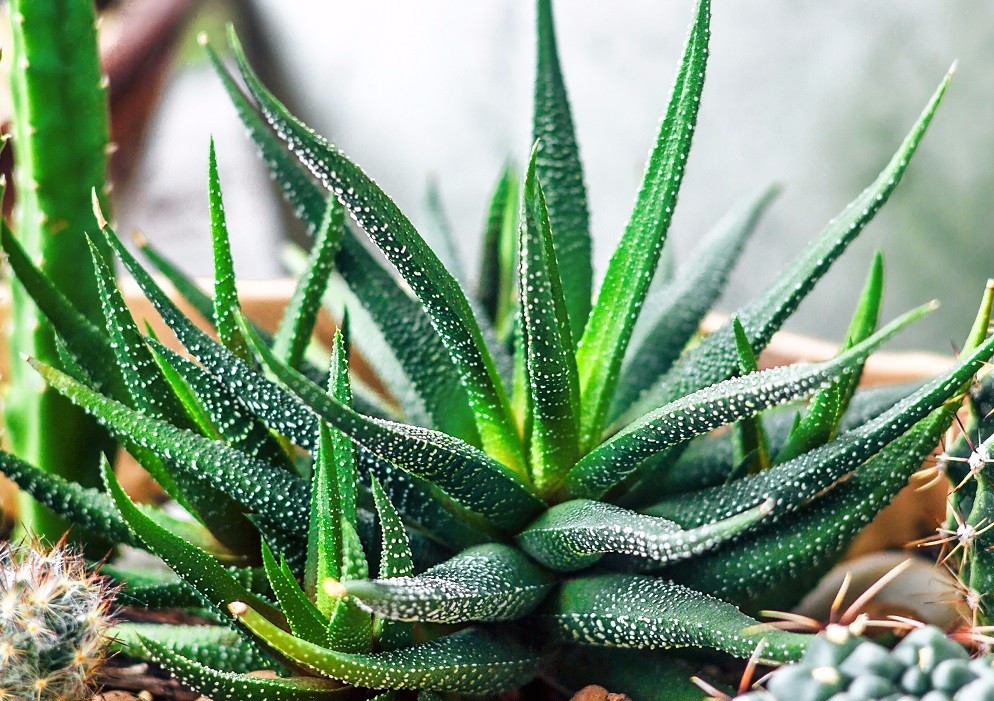
Content
Description
The roots of the plant origin go to the hottest continent of the Earth - South Africa. In the conditions of the subtropical zone, where in summer the temperature is +32 degrees C, in winter - +8, Haworthia lives in the shade of shrubs. The flower was discovered by Adrian Haworth, who explored the flora of Africa. Hence its name, in honor of the botanist.

The amazing ability to retain moisture in the leaves has allowed Haworthia to survive and thrive in arid climates. Flower growth varies from 7 to 20 cm, depending on the species.Outwardly, the leaves resemble aloe, the same fleshy and hard. Triangular shape with a sharp tip. The color is green, sometimes with a blue, brown tint.

This plant is from the Asphodel family. The compact plant stretches very slowly. At home, it is considered an unpretentious flower if you provide it with conditions close to natural. It is a violation in the care of Hawortia that leads to some difficulties in growing.
Views
There has been disagreement among scholars in the final count of the Haworthia species, and they range from 60 to 600 pcs.
All types of Haworthia are divided into three groups:
With hard leaves
The leaves are triangular, green in color. Some specimens have white or similar growths to the plant. This group includes:
- Haworthia pearl... From dense fleshy leaves, up to 8 cm long, -2.5 wide, a rosette is assembled, resembling an open flower of dark green color. The stem is missing. The outer and inner sides of the leaves are strewn with random growths, like white pearls are scattered. The tip is elongated with spikes.
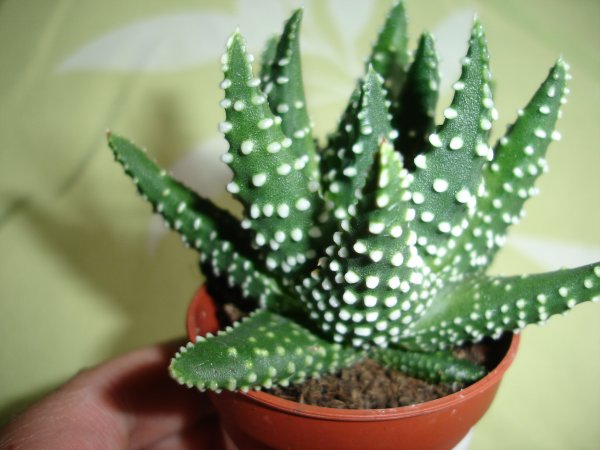
See the bloom of Haworthia in May-June. The flowers are green, small on a long peduncle and are of no decorative value. Haworthia pearl is not demanding in home care.
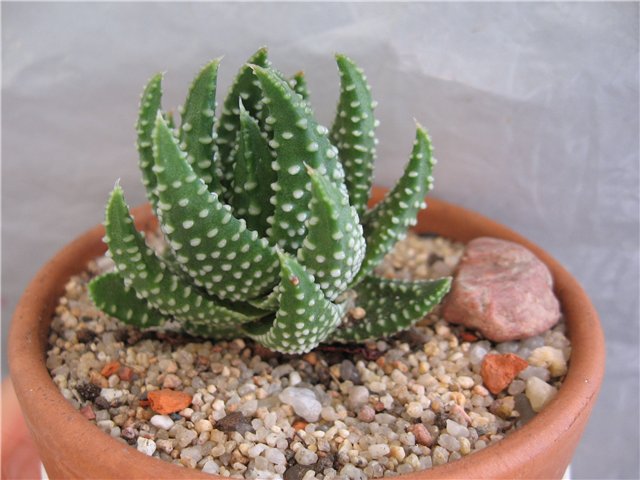
Likes to be outdoors in the summer. In August, the flower should be brought home. Haworthia pearl or pearl-bearing at this time passes into a dormant stage. Propagated in three ways: leaf, daughter shoots, seeds.
Video: home care for Haworthia pearl.
- Haworthia drawn... The shape of the leaves is elongated, green in color. Small beads are showered on warts from all sides. The flower tolerates drought perfectly and underfilling is more favorable for it than overflow. Loves the soil with a neutral reaction, tolerates well saline soils.
- Haworthia sticky... The flower stretches up to 20 cm, like a skyscraper of a house, folded from triangular leaves one above the other. Prefers partial shade, in nature it grows in cracks in rocks and can withstand direct sunlight. Propagated in bunches.
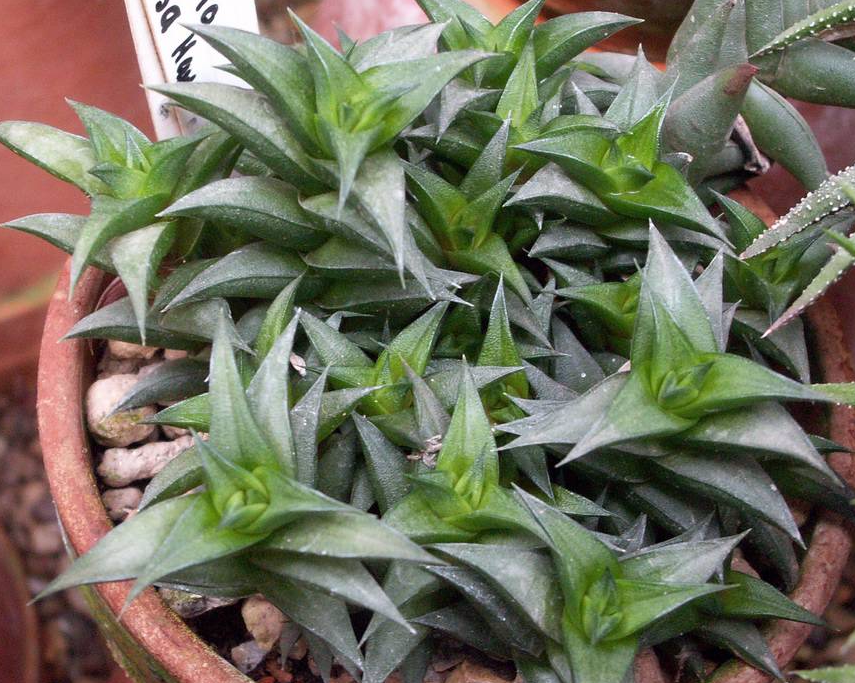
- Haworthia striped... Outwardly, it looks like aloe. Differs in the presence of warts. Flower growths are located only on the lower side. The plant is compact, 15 cm in diameter, likes light windowsills. In the absence of light, growths disappear, and decorativeness is lost. In indoor conditions, the dormant period begins in October and lasts until February.
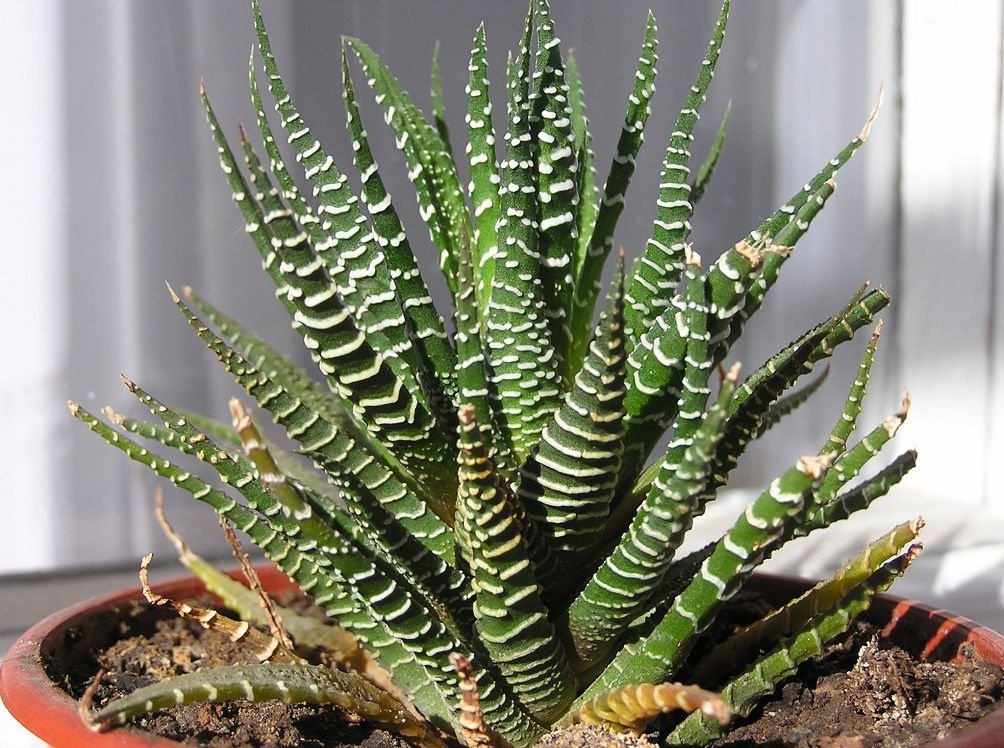
- Haworthia Reinwardt... Triangular leaves, slightly curved inward, form a high rosette up to 15 cm, like a braided braid. The underside of the petals is framed by white growths. During the flowering of Haworthia, tassels with yellow-green flowers appear.
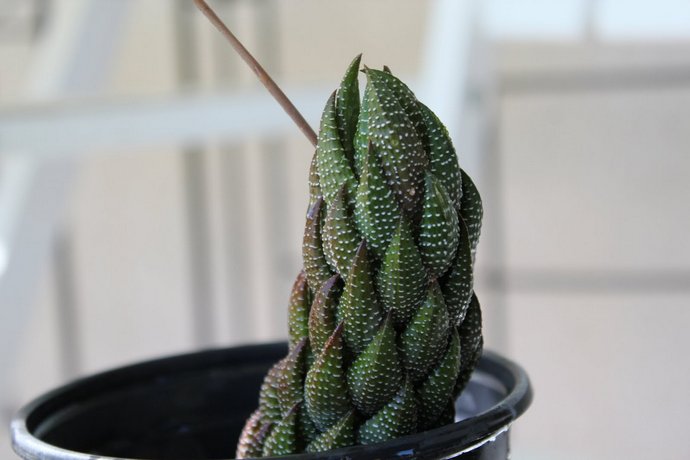
Herbaceous
A stemless rosette is formed by juicy, soft leaves with cilia. Among them are:
- Haworthia herbaceous... A dwarf plant with a miniature rosette size - 5 cm in diameter. The color ranges from green to brown.
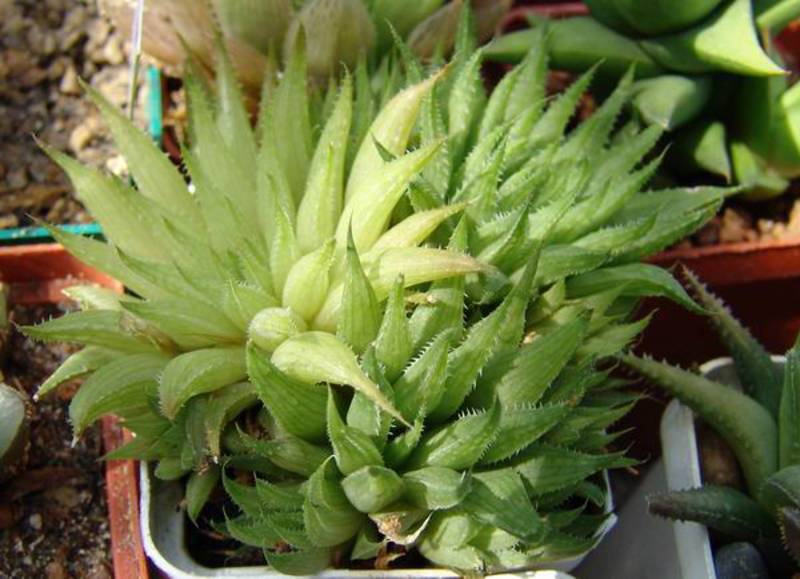
- Haworthia cobweb... A dwarf flower with long cilia.

- Haworthia netted... The originality of the plant in color, which goes from yellow to green. On the surface of the leaves, patterns in the form of nets are formed.
Window
The uniqueness of the group is manifested in transparent leaves, like crystal ones. The light zone can be at the ends of the leaves and near the base.
Leaves deeply embedded in the ground play the role of illumination at the base of the outlet. The shape is different: ovoid, cylindrical, triangular. Color - emerald, terracotta.
This group includes:
- Haworthia Maugani... The cylindrical shape of the leaves gathers the rosette into a bunch. There is a pattern - all leaves are of the same length.
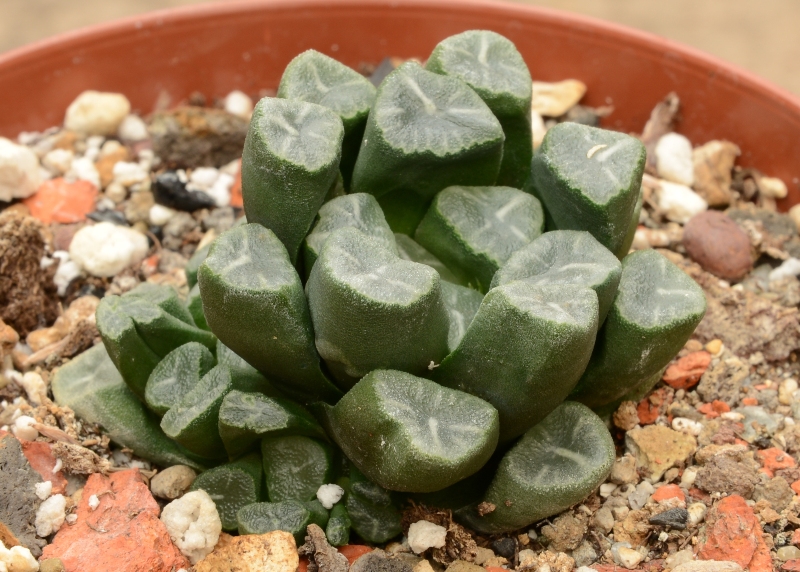
- Haworthia trunkata or chopped off... The plant is no more than 8 cm in diameter. A feature of the flower is its short, irregularly shaped leaves with transparent ends. They are arranged in two rows. Their length is the same and it seems that they were cut off obliquely.
During flowering, it throws out a long peduncle. At the crown, the inflorescences are collected in a brush. Breeders use Hawortia trunkata for the formation and cultivation of new varieties and hybrids. The trunkata derivative is very different in characteristics: the shape of the windows, the rosette, the presence of a pattern on the window, multi-colored leaves. The new works and the parent are united by the slow growth.

What conditions are required depending on the season
Some canons should be adhered to at different times of the year.
Below you can view the nuances of care and maintenance for the Haworthia indoor flower in table format:
| Lighting | Loves diffused light, can grow in partial shade. On the northern window sill, artificial illumination of the flower will be required, on the south side - shading. |
| Temperature | Optimal in summer - 20 degrees C, at higher modes, increase the amount of light. Winter -10-12 degrees S. |
| Humidity | There are no special requirements. In summer it is recommended to take it to the balcony. |
| The soil | Succulent soil, fine gravel, broken shell rock, clay, sand (3: 2: 1: 3: 3). |
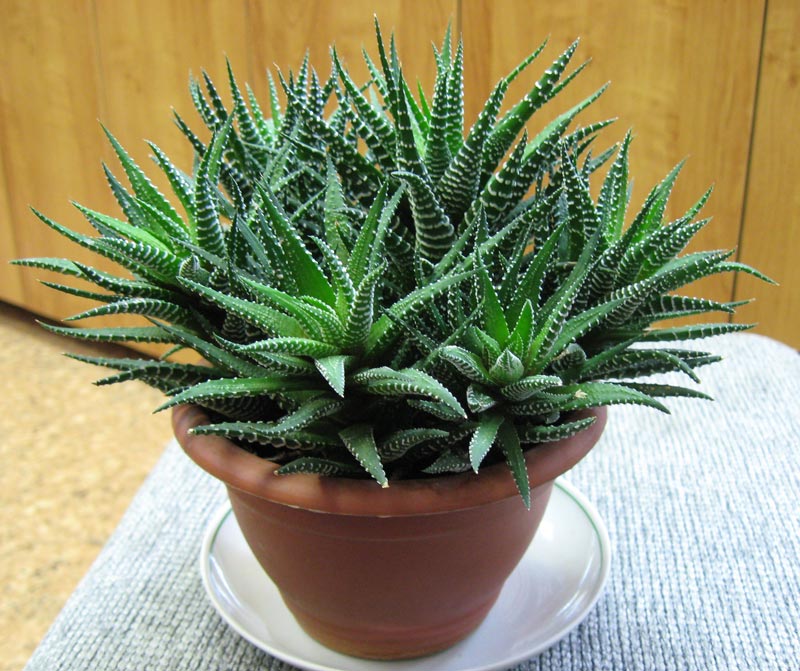
How to plant and how to transplant Hawortia
Before planting Hawortia, you should take care of the soil. The flower feels great in "heavy" soil. The land can be taken for succulent plants in a flower shop by adding clay and expanded clay to it.
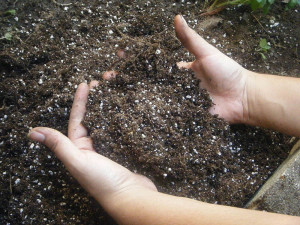
For self-preparation, mix clay-sod, garden soil, peat, sand in the ratio: 1.5: 2: 3: 1. Use charcoal and pine needles as additional components. They will increase breathability.
Pay special attention to the choice of the pot. The root system of Haworthia is shallow, so the transplant pots should be shallow but wide. If the windows face south and west, it is better to buy light colors so that the ground does not overheat.
Don't rush to plant the plant in a large pot right away. The capacity increases with the growth of the rhizome. The next pot is taken 1 cm larger than the previous one. Since the hovartia loves to grow in cramped conditions. The shape of the flowerpot is better round, the material is plastic.

And how to transplant the Haworthia flower correctly? Transplanting young specimens should be carried out annually in the spring. For transplanting Haworthia, use the transhipment method. Pull the plant out, examine the rhizome, if there are damaged areas, cut it off and sprinkle the cut with activated carbon.
Cover the bottom of the pot with a layer of drainage, then a small layer of soil and plant the plant, sprinkle new soil on the sides. It is not necessary to water the plant in the first three days after transplanting. This will make it possible for the flower to survive stress. Adults Haworthia should be transplanted once every 2-3 years.
Important! When the roots die off, transplant should be done immediately.
Video: Havortia transplant.
Home care
Haworthia is unpretentious in home care, it is enough to fulfill some requirements.
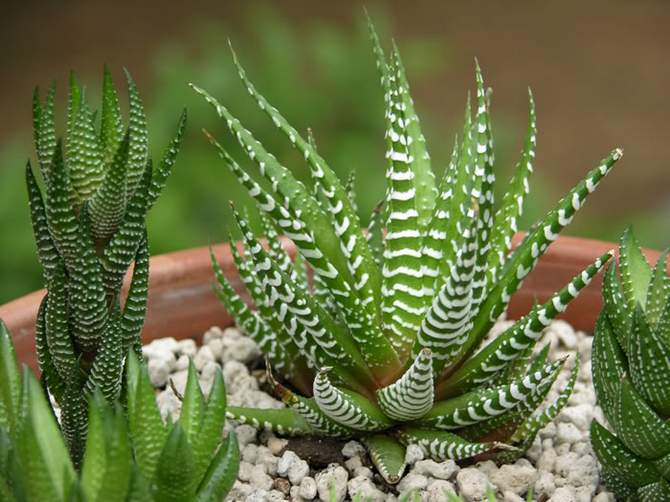
Watering
In summer, irrigate when the top layer of the earth dries up by 2 cm.
Need to know!Liquid must not enter the socket. This will lead to the death of the flower.
In winter, Haworthia has a dormant period and rarely needs watering. But if the lump is completely dry, this is a signal for watering. Use water standing or after defrosting the refrigerator.

Top dressing
As a spring-summer top dressing (April-August), use fertilizer for succulents (once every 30 days). Reduce the dose by 2 times than recommended in the instructions.
Important! Do not feed the transplanted flowers for 3 months. Since the new soil already contains nutrients.
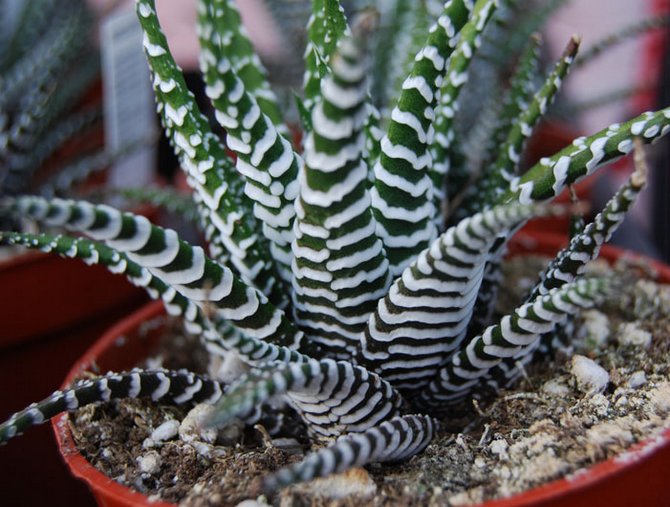
Bloom
Blossoming period of Haworthia May-June. The plant produces a long peduncle, on which white racemose inflorescences will appear.
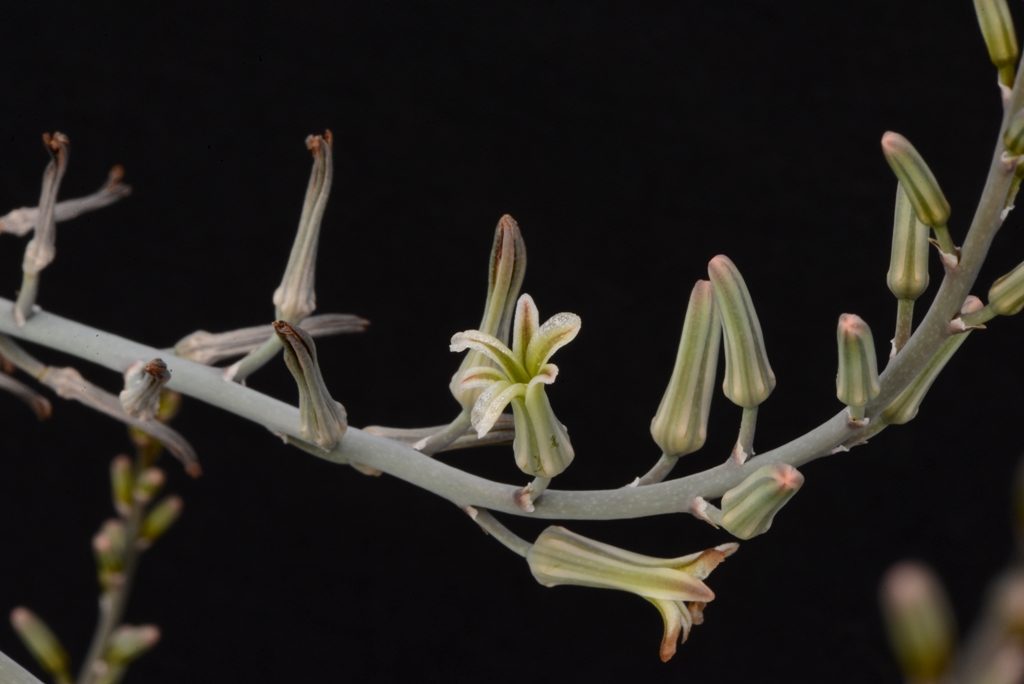
There is a pattern - after flowering, the rosette dies. To prevent this from happening, it is better to delete it immediately.
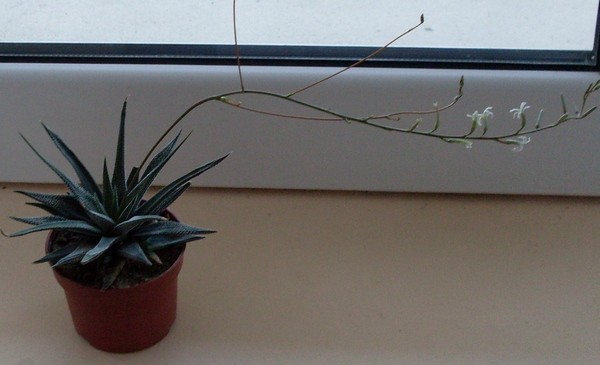
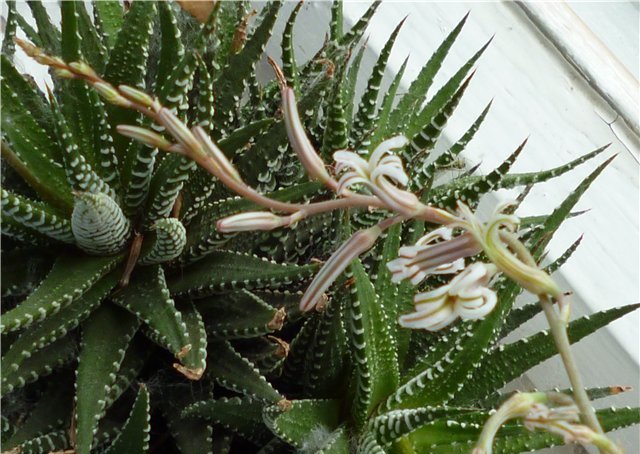
Dormant period
In winter, the plant enters a dormant stage. To do this, the temperature is reduced to 12 degrees C. But when Haworthia begins a period of rest, it must receive light in full mode.
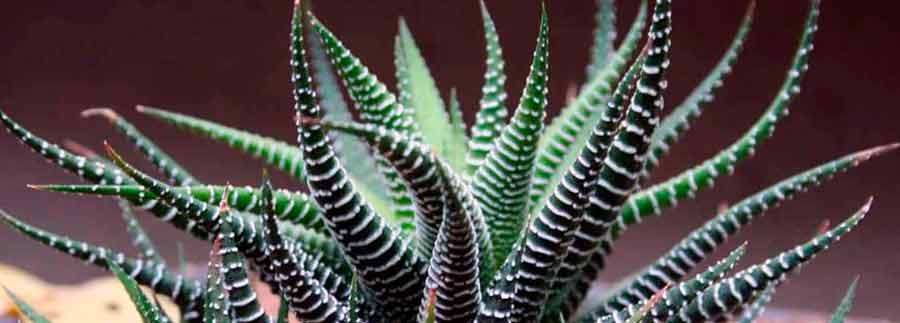
As you can see, caring for Hawortia at home is not so difficult. Any grower can do this!
Video: how to care for Hawortia.
Diseases and pests
Deviations from proper home care for Hawortia can cause the following consequences:
- Leaves turn yellow - excess fertilizers.
- At Haworthia, the leaves began to rot, turned black, darkened - a lack of heat or a sharp temperature drop.
- The decorative appearance is lost - not enough light.
Diseases that can affect Hawortia are shown in the table below:
| Name | Symptoms | Fight | Prevention |
| Spider mite | A spider web appears, framing the flower. At the tips of the leaves, pests gather in the form of a stirring mass. | Wash the leaves with soapy water to reduce the pest population.
Place the flower in a plastic bag and treat with acaricides, eg Flumite, Borneo. Leave closed for a few days. After 7 days, repeat the procedure. |
Spray plants in hot and dry weather. |
| Shield | Spots appear on the leaves, then a sticky liquid. | At an early stage, Hawortia is treated with insecticides. The leaves are pre-wiped with a cotton swab dipped in alcohol. Repeat the treatment in a week. | Inspect plants regularly. |
| Mealybug | At Haworthia, the leaves are deformed and dry out. Visually, you can see cotton-like wax deposits. | Among folk remedies, use the treatment with infusion of tobacco, garlic. Chemicals "Aktellik", "Metaphos". | Daily inspection of plants. Keep the leaves clean. In dry weather, spray flowers. |
| Root rot | The root system turns black. | Restore proper watering. Dig up the affected flowers, remove the rotten areas to living tissue, sprinkle the cut with activated carbon. | Do not overmoisten the soil. Sterilize the instrument, homemade soil. |

Reproduction
There are several methods of growing and breeding Haworthia: children, leaves, seeds.
Daughter sockets
- During the spring transplant, remove the flower from the pot.
- Free the root system from the ground and carefully separate the young shoot with the root.
- Treat the separation site with foundation, if there is no such drug, you can use crushed activated carbon.
- Leave the plant to dry for a few hours.
- Prepare a small flowerpot, cover the bottom with drainage, a layer of soil and plant the flower.
- Compress the socket with earth. To avoid voids, lightly tap the sides of the pot.
- Drizzle with a small amount of settled or filtered water.
- Do not water a young plant until the soil is completely dry.
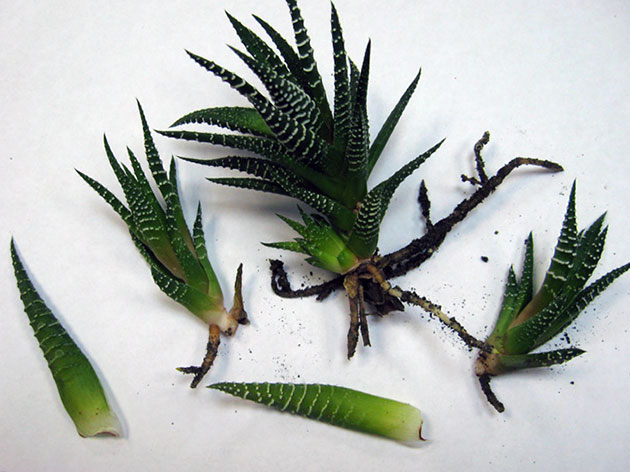
The daughter outlet can be detached without removing the mother bush. And how to separate the children from Haworthia?
- To do this, use a sharp knife. Pre-treat it with alcohol.
- Cut off the shoot and treat with a fungicide. Leave to dry for a day.
- Plant a socket in a pot. Moisten the soil around the edges of the pot.
- Do not allow water to enter the outlet.
- Resume normal watering after rooting after about three weeks.
- Install the flowerpot in a shaded place.
Sheet
- To propagate Haworthia with a sheet, you must separate the sheet near the base (you can use your hands or a sterilized knife).
- Leave it in the air for 2-3 days.
- For rooting, a wet loose substrate or sand is used.
- After planting, do not water for a month. During this period, roots will appear.
Seeds
For propagation of Haworthia by seeds, it is necessary to use freshly harvested planting material. Since over time, its germination decreases. If you buy from a flower center, pay attention to the collection times.
Sow the seeds on the surface of wet sand, slightly pressing inward. Cover the container with glass or cling film, set in a bright place. Soil temperature 15-20 degrees C.
Havortia's planting material does not have a dormant period, so you can sow at any time.Spring planting is good because it does not require additional lighting.
If the seeds are sown in the fall, artificial lighting will be required after 7 days. Shoots will appear in 1 month. After 6 months, a pick should be made.

Video: reproduction of Haworthia
Haworthia is an excellent gift for a novice grower, and she also has very little home care requirements. And most importantly, if you forgot to water, it will only benefit the plant.

